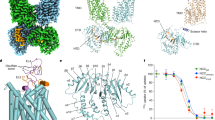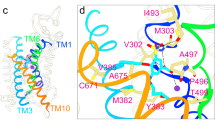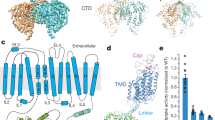Abstract
Transmembrane sodium-ion gradients provide energy that can be harnessed by 'secondary transporters' to drive the translocation of solute molecules into a cell. Decades of study have shown that such sodium-coupled transporters are involved in many physiological processes, making them targets for the treatment of numerous diseases. Within the past year, crystal structures of several sodium-coupled transporters from different families have been reported, showing a remarkable structural conservation between functionally unrelated transporters. These atomic-resolution structures are revealing the mechanism of the sodium-coupled transport of solutes across cellular membranes.
This is a preview of subscription content, access via your institution
Access options
Subscribe to this journal
Receive 51 print issues and online access
$199.00 per year
only $3.90 per issue
Buy this article
- Purchase on Springer Link
- Instant access to full article PDF
Prices may be subject to local taxes which are calculated during checkout






Similar content being viewed by others
References
Quick, M. W. (ed.) Transmembrane Transporters (Wiley-Liss, 2002).
Roux, M. J. & Supplisson, S. Neuronal and glial glycine transporters have different stoichiometries. Neuron 25, 373–383 (2000).
Chakrabarti, A. C. & Deamer, D. W. Permeability of lipid bilayers to amino acids and phosphate. Biochim. Biophys. Acta 1111, 171–177 (1992).
Supplisson, S. & Roux, M. J. Why glycine transporters have different stoichiometries. FEBS Lett. 529, 93–101 (2002).
Sobczak, I. & Lolkema, J. S. Structural and mechanistic diversity of secondary transporters. Curr. Opin. Microbiol. 8, 161–167 (2005).
Wright, E. M. & Turk, E. The sodium/glucose cotransport family SLC5. Pflügers Arch. 447, 510–518 (2004).
Hebert, S. C., Mount, D. B. & Gamba, G. Molecular physiology of cation-coupled Cl− cotransport: the SLC12 family. Pflügers Arch. 447, 580–593 (2004).
Sonders, M. S., Quick, M. & Javitch, J. A. How did the neurotransmitter cross the bilayer? A closer view. Curr. Opin. Neurobiol. 15, 296–304 (2005).
Gamba, G. Molecular physiology and pathophysiology of electroneutral cation-chloride cotransporters. Physiol. Rev. 85, 423–493 (2005).
Murphy, D. L., Lerner, A., Rudnick, G. & Lesch, K. P. Serotonin transporter: gene, genetic disorders, and pharmacogenetics. Mol. Interv. 4, 109–123 (2004).
Busch, W. & Saier, M. H. Jr The transporter classification (TC) system, 2002. Crit. Rev. Biochem. Mol. Biol. 37, 287–337 (2002).
Hediger, M. A. et al. The ABCs of solute carriers: physiological, pathological and therapeutic implications of human membrane transport proteins. Pflügers Arch. 447, 465–468 (2004).
Saier, M. H. Jr A functional-phylogenetic classification system for transmembrane solute transporters. Microbiol. Mol. Biol. Rev. 64, 354–411 (2000).
Saier, M. H. Jr, Tran, C. V. & Barabote, R. D. TCDB: the Transporter Classification Database for membrane transport protein analyses and information. Nucleic Acids Res. 34, D181–D186 (2006). References 11, 13 and 14 provide a comprehensive classification system for membrane transport proteins that includes ion channels as well as primary and secondary transporters.
Mitchell, P. A general theory of membrane transport from studies of bacteria. Nature 180, 134–136 (1957).
Mitchell, P. in Advances in Enzymology and Related Areas of Molecular Biology (ed. Nord, F. F.) 33–87 (Interscience, 1967).
Patlak, C. S. Contributions to the theory of active transport: II. The gate type non-carrier mechanism and generalizations concerning tracer flow, efficiency, and measurement of energy expenditure. Bull. Math. Biophys. 19, 209–235 (1957).
Vidaver, G. A. Inhibition of parallel flux and augmentation of counter flux shown by transport models not involving a mobile carrier. J. Theor. Biol. 10, 301–306 (1966).
Jardetzky, O. Simple allosteric model for membrane pumps. Nature 211, 969–970 (1966).
Murakami, S., Nakashima, R., Yamashita, E. & Yamaguchi, A. Crystal structure of bacterial multidrug efflux transporter AcrB. Nature 419, 587–593 (2002).
Huang, Y., Lemieux, M. J., Song, J., Auer, M. & Wang, D. N. Structure and mechanism of the glycerol-3-phosphate transporter from Escherichia coli . Science 301, 616–620 (2003).
Abramson, J. et al. Structure and mechanism of the lactose permease of Escherichia coli . Science 301, 610–615 (2003).
Yernool, D., Boudker, O., Jin, Y. & Gouaux, E. Structure of a glutamate transporter homologue from Pyrococcus horikoshii . Nature 431, 811–818 (2004).
Hunte, C. et al. Structure of a Na+/H+ antiporter and insights into mechanism of action and regulation by pH. Nature 435, 1197–1202 (2005).
Yamashita, A., Singh, S. K., Kawate, T., Jin, Y. & Gouaux, E. Crystal structure of a bacterial homologue of Na+/Cl−-dependent neurotransmitter transporters. Nature 437, 215–223 (2005).
Screpanti, E. & Hunte, C. Discontinuous membrane helices in transport proteins and their correlation with function. J. Struct. Biol. 159, 261–267 (2007).
Faham, S. et al. The crystal structure of a sodium galactose transporter reveals mechanistic insights into Na+/sugar symport. Science 321, 810–814 (2008).
Weyand, S. et al. Structure and molecular mechanism of a nucleobase-cation-symport-1 family transporter. Science 322, 709–713 (2008).
Wright, E. M., Loo, D. D. F., Hirayama, B. A. & Turk, E. Surprising versatility of Na+-glucose cotransporters: SLC5. Physiology 19, 370–376 (2004).
Chen, N. H., Reith, M. E. & Quick, M. W. Synaptic uptake and beyond: the sodium- and chloride-dependent neurotransmitter transporter family SLC6. Pflügers Arch. 447, 519–531 (2004).
Barker, E. L., Moore, K. R., Rakhshan, F. & Blakely, R. D. Transmembrane domain I contributes to the permeation pathway for serotonin and ions in the serotonin transporter. J. Neurosci. 19, 4705–4717 (1999).
Rudnick, G. Serotonin transporters — structure and function. J. Membr. Biol. 213, 101–110 (2006).
Kanner, B. I. & Zomot, E. Sodium-coupled neurotransmitter transporters. Chem. Rev. 108, 1654–1668 (2008).
Ben-Yona, A. & Kanner, B. I. Transmembrane domain 8 of the γ-aminobutyric acid transporter GAT-1 lines a cytoplasmic accessibility pathway into its binding pocket. J. Biol. Chem. 284, 9727–9732 (2009).
Slotboom, D. J., Lolkema, J. S. & Konings, W. N. Membrane topology of the C-terminal half of the neuronal, glial, and bacterial glutamate transporter family. J. Biol. Chem. 271, 31317–31321 (1996).
Grunewald, M., Bendahan, A. & Kanner, B. I. Biotinylation of single cysteine mutants of the glutamate transporter GLT-1 from rat brain reveals its unusual topology. Neuron 21, 623–632 (1998).
Seal, R. P. & Amara, S. G. A reentrant loop domain in the glutamate carrier EAAT1 participates in substrate binding and translocation. Neuron 21, 1487–1498 (1998).
Toyoshima, C., Nakasako, M., Nomura, H. & Ogawa, H. Crystal structure of the calcium pump of sarcoplasmic reticulum at 2.6 Å resolution. Nature 405, 647–655 (2000).
Dutzler, R., Campbell, E. B., Cadene, M., Chait, B. T. & MacKinnon, R. X-ray structure of a ClC chloride channel at 3.0 Å reveals the molecular basis of anion selectivity. Nature 415, 287–294 (2002).
Singh, S. K., Piscitelli, C. L., Yamashita, A. & Gouaux, E. A competitive inhibitor traps LeuT in an open-to-out conformation. Science 322, 1655–1661 (2008). This paper provides a crystallographic and functional analysis of LeuT with several different ligands that correlates the occluded state to transportable ligands and identifies a tryptophan as a competitive inhibitor that traps an open-to-out conformation.
Shi, L., Quick, M., Zhao, Y., Weinstein, H. & Javitch, J. A. The mechanism of a neurotransmitter:sodium symporter-inward release of Na+ and substrate is triggered by a substrate in a second binding site. Mol. Cell 30, 667–677 (2008).
Celik, L., Schiott, B. & Tajkhorshid, E. Substrate binding and formation of an occluded state in the leucine transporter. Biophys. J. 94, 1600–1612 (2008).
Hilger, D., Bohm, M., Hackmann, A. & Jung, H. Role of Ser-340 and Thr-341 in transmembrane domain IX of the Na+/proline transporter PutP of Escherichia coli in ligand binding and transport. J. Biol. Chem. 283, 4921–4929 (2008).
De La Vieja, A., Reed, M. D., Ginter, C. S. & Carrasco, N. Amino acid residues in transmembrane segment IX of the Na+/I− symporter play a role in its Na+ dependence and are critical for transport activity. J. Biol. Chem. 282, 25290–25298 (2007). The mutation of conserved serine and threonine residues in TM9 of the NIS transporter (SSS family) shows that they are involved in Na+ binding and translocation.
Zhou, Y., Zomot, E. & Kanner, B. I. Identification of a lithium interaction site in the GABA transporter GAT-1. J. Biol. Chem. 281, 22092–22099 (2006).
Noskov, S. Y. & Roux, B. Control of ion selectivity in LeuT: two Na+ binding sites with two different mechanisms. J. Mol. Biol. 377, 804–818 (2008).
Caplan, D. A., Subbotina, J. O. & Noskov, S. Y. Molecular mechanism of ion-ion and ion-substrate coupling in the Na+-dependent leucine transporter LeuT. Biophys. J. 95, 4613–4621 (2008).
Talvenheimo, J., Fishkes, H., Nelson, P. J. & Rudnick, G. The serotonin transporter-imipramine “receptor”. J. Biol. Chem. 258, 6115–6119 (1983).
Gu, H. H., Wall, S. & Rudnick, G. Ion coupling stoichiometry for the norepinephrine transporter in membrane vesicles from stably transfected cells. J. Biol. Chem. 271, 6911–6916 (1996).
Keynan, S. & Kanner, B. I. γ-Aminobutyric acid transport in reconstituted preparations from rat brain: coupled sodium and chloride fluxes. Biochemistry 27, 12–17 (1988).
Diez-Sampedro, A., Eskandari, S., Wright, E. M. & Hirayama, B. A. Na+-to-sugar stoichiometry of SGLT3. Am. J. Physiol. Renal Physiol. 280, F278–F282 (2001).
Mackenzie, B., Loo, D. D. F. & Wright, E. M. Relationships between Na+/glucose cotransporter (SGLT1) currents and fluxes. J. Membr. Biol. 162, 101–106 (1998).
Eskandari, S. et al. Thyroid Na+/I- symporter. Mechanism, stoichiometry, and specificity. J. Biol. Chem. 272, 27230–27238 (1997).
Forrest, L. R., Tavoulari, S., Zhang, Y. W., Rudnick, G. & Honig, G. Identification of a chloride ion binding site in Na+/Cl− -dependent transporters. Proc. Natl Acad. Sci. USA 104, 12761–12766 (2007).
Zomot, E. et al. Mechanism of chloride interaction with neurotransmitter:sodium symporters. Nature 449, 726–730 (2007).
Singh, S., Yamashita, A. & Gouaux, E. Antidepressant binding site in a bacterial homologue of neurotransmitter transporters. Nature 448, 952–956 (2007). This paper presents a structural concept for the non-competitive inhibition of NSS transporters by tricyclic antidepressants.
Boudker, O., Ryan, R., Yernool, D., Shimamoto, K. & Gouaux, E. Coupling substrate and ion binding to extracellular gate of a sodium-dependent aspartate transporter. Nature 445, 387–393 (2007).
Kavanaugh, M. P., Bendahan, A., Zerangue, N., Zhang, Y. & Kanner, B. I. Mutation of an amino acid residue influencing potassium coupling in the glutamate transporter GLT-1 induces obligate exchange. J. Biol. Chem. 272, 1703–1708 (1997).
Keyes, S. R. & Rudnick, G. Coupling of transmembrane proton gradients to platelet serotonin transport. J. Biol. Chem. 257, 1172–1176 (1982).
Forrest, L. R. et al. Mechanism for alternating access in neurotransmitter transporters. Proc. Natl Acad. Sci. USA 105, 10338–10343 (2008). This paper proposes a model for an inward-facing conformation of LeuT based on the structure of outward-facing LeuT 2013>Leu and the inverted structural pseudo-symmetry.
Jacobs, M. T., Zhang, Y. W., Campbell, S. D. & Rudnick, G. Ibogaine, a noncompetitive inhibitor of serotonin transport, acts by stabilizing the cytoplasm-facing state of the transporter. J. Biol. Chem. 282, 29441–29447 (2007).
Zhang, Y.-W. & Rudnick, G. The cytoplasmic substrate permeation pathway of serotonin transporter. J. Biol. Chem. 281, 36213–36220 (2006).
Zhang, Y. W. & Rudnick, G. Cysteine-scanning mutagenesis of serotonin transporter intracellular loop 2 suggests an α-helical conformation. J. Biol. Chem. 280, 30807–30813 (2005).
Zhou, Z. et al. LeuT-desipramine structure reveals how antidepressants block neurotransmitter uptake. Science 317, 1390–1393 (2007).
Apparsundaram, S., Stockdale, D. J., Henningsen, R. A., Milla, M. E. & Martin, R. S. Antidepressants targeting the serotonin reuptake transporter act via a competitive mechanism. J. Pharmacol. Exp. Ther. 327, 982–990 (2008).
Hirayama, B. A., Diez-Sampedro, A. & Wright, E. M. Common mechanisms of inhibition for the Na+/glucose (hSGLT1) and Na+/Cl−/GABA (hGAT1) cotransporters. Br. J. Pharmacol. 134, 484–495 (2001). This paper demonstrates a common principle for inhibition between two functionally unrelated families that hints at the underlying structural conservation.
Hayward, S. & Berendsen, H. J. Systematic analysis of domain motions in proteins from conformational change: new results on citrate synthase and T4 lysozyme. Proteins 30, 144–154 (1998).
Acknowledgements
This work was supported by the US National Institutes of Health. E.G. is an investigator with the Howard Hughes Medical Institute. We thank R. Hibbs, K. Hollenstein, H. Owen, S. Singh and A. Sobolevsky for helpful comments and L. Vaskalis for assistance with the figures.
Author information
Authors and Affiliations
Ethics declarations
Competing interests
The authors declare no competing financial interests.
Additional information
Reprints and permissions information is available at http://www.nature.com/reprints.
Correspondence should be addressed to E.G. (gouauxe@ohsu.edu).
Rights and permissions
About this article
Cite this article
Krishnamurthy, H., Piscitelli, C. & Gouaux, E. Unlocking the molecular secrets of sodium-coupled transporters. Nature 459, 347–355 (2009). https://doi.org/10.1038/nature08143
Published:
Issue Date:
DOI: https://doi.org/10.1038/nature08143
This article is cited by
-
Structure and function of H+/K+ pump mutants reveal Na+/K+ pump mechanisms
Nature Communications (2022)
-
Substrate-induced conformational dynamics of the dopamine transporter
Nature Communications (2019)
-
Locking Two Rigid-body Bundles in an Outward-Facing Conformation: The Ion-coupling Mechanism in a LeuT-fold Transporter
Scientific Reports (2019)
-
Rigorous sampling of docking poses unveils binding hypothesis for the halogenated ligands of L-type Amino acid Transporter 1 (LAT1)
Scientific Reports (2019)
-
Function and Regulation of Acid Resistance Antiporters
The Journal of Membrane Biology (2019)
Comments
By submitting a comment you agree to abide by our Terms and Community Guidelines. If you find something abusive or that does not comply with our terms or guidelines please flag it as inappropriate.



